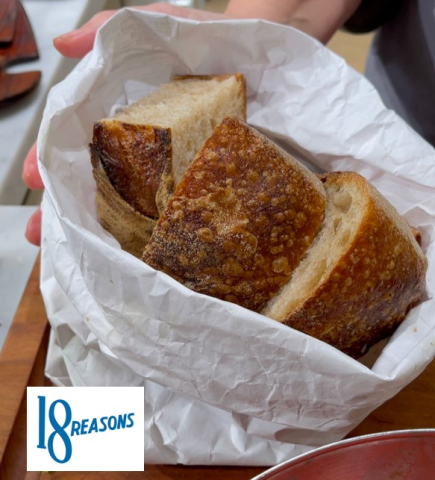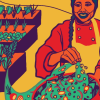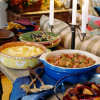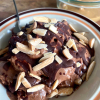Leftovers can be ingredients to incorporate into flavorful weeknight cooking. Old bread is a favorite of Viola's, Italian cooking, and the subject of the first class she taught at 18 Reasons over a decade ago. In less than 10 minutes, she will show how to feed 8 to 10 people from half a loaf of week-old bread, a few humble vegetables and condiments, one can of tuna, and one of peeled tomatoes. You can adjust the vegetables, herbs, and other ingredients in the recipes to make use of what you have in your own kitchen.
Viola Buitoni was born and raised in Italy and has called the Bay Area home since 2003. For the last 12 years, she has taught home cooks how to cross local agricultural bounty with traditional Italian pantry staples to create simple and flavorsome dishes. She just finished collecting her experiences in a book, Italy by Ingredient (2023). Find Viola on Instagram @violabuitoni and @italybyingredient
RECIPES:
Minestra di Pane Vecchio, "Week-Old Bread Soup" (by Viola Buitoni)
Serves: 5 to 6 people
INGREDIENTS
- 1/2 yellow onion
- 2 carrots
- 1 celery rib
- 2 tender medium zucchini
- 2 marjoram sprigs
- 3 tablespoons olive oil + more for finishing
- salt and pepper
- 1/2 pound week-old bread, torn in chunks
- 14 ounces can peeled tomato
- pepper to taste
- olive oil for garnishing
- grated pecorino or parmigiano for serving
INSTRUCTIONS
- Prepare the vegetables and herbs: slice the onion thinly. Peel and roughly chop the carrot. Slice the celery in thin crescents. Halve the zucchini length wise then slice in 1/8” half moons. Pluck the pretty tips from the marjoram sprigs, then strip off the rest of the leaves, and chop them finely.
- Pour 2 tablespoon of the olive oil in a saucepan and heat on medium until hovering a hand over it feels uncomfortable. Sprinkle with 1/2 teaspoon salt, then add the onions, carrots, celery, and half the marjoram. Season with 1/2 teaspoon salt, and stir well.
- Sauté for about 5 minutes, stirring often, until the onions have lost their stiffness and the carrot and celery look sweaty and slightly yield to pressure.
- Meanwhile, empty the can of tomatoes into a bowl. Fill the empty can with water, swirl it to collect the juice clinging to the sides and pour it into the bowl.
- Season the tomatoes with 1 teaspoon salt and squash them with your hands.
- Add the zucchini to the saucepan and continue sweating all the vegetables until the zucchini is glossy and just tender, about 5 minutes.
- Add the chunks of bread and stir well to coat them in oil and vegetables yumminess.
- Raise the heat all the way, add the tomatoes, then pour water until the bread is covered.
- When the liquid comes to a boil, lower the heat to a simmer, partially cover the pan, and simmer for about 10 minutes, checking periodically to make sure the bread is not sticking.
- Break up the bread chunks with your wooden spoon, and stir.
- Sample the soup and adjust salt and pepper to suit your palate. Stir in the rest of the chopped marjoram.
- Serve warm, finished with a thread of olive oil, garnished with the saved marjoram leaves and with grated cheese on the side.
Note from Viola: Wasting has no upsides, particularly when it comes to food. I adore this soup, for which I always have the main ingredient—stale bread. I can throw it together in a pinch, with whatever else the season puts in my pantry. This is but one version, I have applied the same technique to many a vegetable—mushrooms and pumpkins in the fall, green beans and shelling peas in the spring, fresh tomatoes and basil in the summer. I cherish the heat it gives on a cold winter day, but I have eaten it barely warm in the early fall and chilled in the dead of summer, loving it just as much. You can also serve it topped with a poached egg or a complete meal.
Panzanella Invernale, "Winter Bread Salad" (by Viola Buitoni)
- 1/4 medium red onion
- red wine vinegar
- 1/2 ball of red radicchio
- 1/2 loaf crusty week-old bread, about half pound
- 1 tsp dried oregano
- 6 ounces can of tuna in olive oil, drained and flaked
- 1/4 cup pitted green olives, well rinsed
- 2 Tbsp hot chilis in olive oil, roughly chopped (optional)
- 1/2 cup peeled almonds
- 1/4 cup dill tips
- salt and pepper
- extra virgin olive oil
INSTRUCTIONS
- Slice the onion wedge in thin scythes moving your knife across from stem to root. Place the scythes in a bowl, drizzle with vinegar, add 5 to 6 ice cubes, and cover with water. Let stand for crisping and flash pickling while you are assembling the salad.
- Shred the radicchio with a knife, drop it into a salad spinner, add 8 to 10 ice cubes and cover with water.
- Tear the bread in big chunks, quickly dip it in water, then squeeze decisively, until no water comes out. Roughly crumble into a big salad bowl. Season with salt to suite your palate and toss well. Add a pinch of pepper, and the dried oregano, then toss again.
- Sprinkle with about 2 tablespoons of vinegar, then toss well. The back of your nose should feel the tang of the vinegar without being overwhelmed by it. If your olfactory response is underwhelming, then sprinkle a dash more vinegar. Or, if your nostrils are overwhelmed, add a little salt to offset the vinegar’s acidity.
- Drain the onions. Drain and spin the radicchio.
- Add the tuna, olives, chilis, the radicchio, and about two thirds of the onion to the bowl with the bread. Toss well to disperse the ingredients evenly. Douse with 2 to 3 tablespoons of olive oil and toss again.
- Taste to ensure it suits your palate, and adjust seasonings as needed to thrill you.
- If you have the time, let your creation sit for about an hour, the flavors will meld even better.
- When you are ready to serve it, top with one more generous glug of olive oil, artfully scatter the remaining onions all over it, dust with the almonds, and frill with the dill.
More recipes, cooking tips, and videos from 18 Reasons:
- Vegetable & Cheese Fritters with Chimichurri Sauce
- Chef Hacks to Reduce Wasted Food
- Radish Greens & Chicken Pie
- Crispy Cauliflower with Carrot Top Salsa Verde
- Quick Greens Gratin
Learn more about 18 Reasons in this article from Edible East Bay.
18 Reasons is a Chef Partner of the Stop Food Waste campaign. They are a nonprofit cooking school on a mission to empower our community with the confidence and creativity needed to buy, cook, and eat good food every day.












